The Art of Rubens
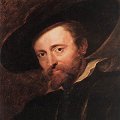 Flemish painter who was the greatest exponent of Baroque painting's dynamism, vitality, and sensuous exuberance. His work is a fusion of the traditions of Flemish realism with the classical tendencies of the Italian Renaissance. Though his masterpieces include portraits and landscapes, Peter Paul Rubens is perhaps best known for his religious and mythological compositions.
Flemish painter who was the greatest exponent of Baroque painting's dynamism, vitality, and sensuous exuberance. His work is a fusion of the traditions of Flemish realism with the classical tendencies of the Italian Renaissance. Though his masterpieces include portraits and landscapes, Peter Paul Rubens is perhaps best known for his religious and mythological compositions.
Early life
Although Rubens' father, Jan, was born a Roman Catholic, his name had appeared on a list of Calvinists as early as 1566. This accounted for the Rubens family's exile to Germany, where Peter Paul was born. Jan Rubens became a diplomatic agent and adviser to the Protestant princess Anna of Saxony (d. 1577), second wife of William the Silent, who led the resistance to Spanish rule of the Netherlands. An unfortunate pregnancy revealed the intimate extent of the relationship between this princess of the house of Orange-Nassau and Rubens' father. She obtained clemency from her husband for Jan, but he and his family were placed under house arrest at Siegen, a Nassau stronghold in Westphalia. The Rubens children were grounded in the classics by their exiled father, who was a doctor of both civil and canon law. Jan died in 1587, after he had been allowed to go to the German city of Cologne. Rubens' mother then took her four surviving children to Antwerp, where Jan had been an alderman.
Antwerp training
At the age of 10, Peter Paul was sent with his brother Philip to a Latin school in Antwerp. In 1590, shortage of money and the need to provide a dowry for his sister Blandina forced Rubens' mother to break off his formal education and send him as a page to the Countess of Lalaing. Soon tired of courtly life, Rubens was allowed to become a painter. He was sent first to his kinsman Tobias Verhaecht, a minor painter of Mannerist landscapes. Having quickly learned the rudiments of his profession, he was apprenticed for four years to an abler master, Adam van Noort, and subsequently to Otto van Veen, one of the most distinguished of the Antwerp Romanists, a group of Flemish artists who had gone to Rome to study the art of antiquity and the Italian Renaissance.
Italian period
In May 1600, with two years' seniority as a master in the Antwerp Guild of St Luke, Rubens set out with Deodatus del Monte, his constant traveling companion and first pupil, for the visual and spiritual adventure of Italy. He was offered employment by Vincenzo I Gonzaga, Duke of Mantua, which duchy held one of the largest and finest collections outside the Vatican of works by Italian artists. During the eight years that Rubens was to call Vincenzo his lord, he had unmatched opportunities for fulfilling his expressed intention "to study at close quarters the works of the ancient and modern masters..."
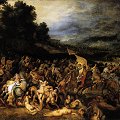 Rubens was sent to Rome (1601-02) by the duke to paint copies of pictures and to live under the protection of Cardinal Montalto. There, through Flemish connections, he obtained his first public commission, to paint three altarpieces for the crypt chapel of St Helena in Santa Croce in Gerusalemme. In Rome the Bolognese painter Annibale Carracci and his assistants were at work in the gallery of the Palazzo Farnese. Their bold scale in drawing and working methods decidedly influenced the young Rubens. He assimilated Venetian colour, light, and loose application of paint first through the works of Tintoretto, then through those of Veronese, long before he could penetrate the inward meaning of Titian's art. Rubens' copies, and his reworking of drawings, offer the most complete survey of the achievement of 16th-century Italian art in a markedly personal revision.
Rubens was sent to Rome (1601-02) by the duke to paint copies of pictures and to live under the protection of Cardinal Montalto. There, through Flemish connections, he obtained his first public commission, to paint three altarpieces for the crypt chapel of St Helena in Santa Croce in Gerusalemme. In Rome the Bolognese painter Annibale Carracci and his assistants were at work in the gallery of the Palazzo Farnese. Their bold scale in drawing and working methods decidedly influenced the young Rubens. He assimilated Venetian colour, light, and loose application of paint first through the works of Tintoretto, then through those of Veronese, long before he could penetrate the inward meaning of Titian's art. Rubens' copies, and his reworking of drawings, offer the most complete survey of the achievement of 16th-century Italian art in a markedly personal revision.
In 1603 he was entrusted with his first diplomatic mission, to take costly presents from Mantua to Philip III and the Spanish court. This mission gave him a first view of the royal collections in Madrid. His resourcefulness and tact in dealing with the temperamental regular Mantuan representative to the Spanish court raised him in the duke's estimation and helped prepare him for future diplomatic missions.
The only major works he executed for Mantua were the three pictures finished in 1605 for the Jesuit Church of SS. Trinita: The Baptism of Christ (Royal Museum of Fine Arts, Antwerp), The Transfiguration (Fine Arts Museum, Nancy), and The Gonzaga Family in Adoration of the Most Holy Trinity (Ducal Palace, Mantua). In the same year he completed the Circumcision for the high altar of the Jesuit Church of Sant' Ambrogio in Genoa. Portraits of court beauties by Rubens were commissioned by the duke for the Gonzaga Gallery, of which Rubens was curator.
Toward the end of 1605, Rubens obtained leave from the Duke of Mantua to continue his studies in Rome. There he shared a house with his brother Philip, then librarian to Cardinal Ascanio Colonna, a member of one of Rome's most wealthy and powerful families. Daily contact with Philip, a brilliant student of the famed Flemish humanist and classical scholar Justus Lipsius, added zest to his personal discovery of the antique world.
 In the summer of 1607 Rubens was asked to accompany the Gonzaga court to the Italian seaside resort of San Pier d'Arena, where he continued to paint with splendour portraits of the Genoese aristocracy. Chronic arrears in payment of his salary, and an ambition to establish himself as an international, rather than just a Mantuan, artist, motivated him to accept other patronage. He received the backing of the wealthy Genoese banker to the papacy, Monsignor Jacopo Serra, who was instrumental in obtaining for him the coveted commission for the painting over the high altar of the Roman Church of Santa Maria in Vallicella. He concurrently painted the altarpiece of the Adoration of the Shepherds for the Oratorian Order in Fermo.
In the summer of 1607 Rubens was asked to accompany the Gonzaga court to the Italian seaside resort of San Pier d'Arena, where he continued to paint with splendour portraits of the Genoese aristocracy. Chronic arrears in payment of his salary, and an ambition to establish himself as an international, rather than just a Mantuan, artist, motivated him to accept other patronage. He received the backing of the wealthy Genoese banker to the papacy, Monsignor Jacopo Serra, who was instrumental in obtaining for him the coveted commission for the painting over the high altar of the Roman Church of Santa Maria in Vallicella. He concurrently painted the altarpiece of the Adoration of the Shepherds for the Oratorian Order in Fermo.
In October 1608 his brother summoned him to their mother's deathbed in Antwerp, but she died before he could reach her. Italy had become Rubens's spiritual home (he usually signed himself Pietro Pauolo') and he considered returning for good, but his success in Antwerp was so immediate and great that he remained there, and in spite of his extensive travels later in his career he never saw Italy again.
Return to Antwerp
Soon after his mother's death Rubens was "bound with golden fetters" to the service of the Spanish Habsburg regents of Flanders. The house that he built for himself, the pride of Antwerp, was filled with paintings, statuary, cameos, coins, and jewels from Renaissance and ancient Roman Italy. He built a private pantheon to house his antiquities. His biggest commission in Flanders was for the decoration of the Jesuit Church St Charles Borromeo in Antwerp (a building he may also have had a hand in designing). He was also the master decorator for its interior and provided oil sketches as designs for the ceiling paintings, on which he was assisted by his most talented pupil, Anthony Van Dyck, and others. Almost all his work there was destroyed by fire in 1718.
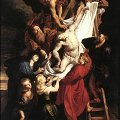 Settling permanently in Flanders, Rubens in October 1609 married Isabella, daughter of Jan Brant, a leading Antwerp humanist. He became not only the court portraitist but a major religious painter. His Baroque altarpieces of The Raising of the Cross (1610) for St. Walburga's in Antwerp and the Descent from the Cross (1611-14) for Antwerp Cathedral established Rubens as the leading painter of Flanders. Because of his prestige, he was allowed to live in Antwerp, rather than in Brussels, where the Flemish court was based. Rubens' international reputation spread partly because of the large number of works produced in his workshop, which came to employ a great number of assistants and apprentices. Many of the large-scale pictures that issued from his studio were in fact painted by these assistants, though the underlying design and certain key areas of paint were done by Rubens himself. To present models of prospective large-scale paintings to clients, Rubens might also sketch out the design beforehand in tones of brown, gray, and white on a small prepared wooden panel only inches high.
Settling permanently in Flanders, Rubens in October 1609 married Isabella, daughter of Jan Brant, a leading Antwerp humanist. He became not only the court portraitist but a major religious painter. His Baroque altarpieces of The Raising of the Cross (1610) for St. Walburga's in Antwerp and the Descent from the Cross (1611-14) for Antwerp Cathedral established Rubens as the leading painter of Flanders. Because of his prestige, he was allowed to live in Antwerp, rather than in Brussels, where the Flemish court was based. Rubens' international reputation spread partly because of the large number of works produced in his workshop, which came to employ a great number of assistants and apprentices. Many of the large-scale pictures that issued from his studio were in fact painted by these assistants, though the underlying design and certain key areas of paint were done by Rubens himself. To present models of prospective large-scale paintings to clients, Rubens might also sketch out the design beforehand in tones of brown, gray, and white on a small prepared wooden panel only inches high.
The demand for Rubens's work was extraordinary, and he was able to meet it only because he ran an extremely efficient studio. It is not known how many pupils or assistants he had because as court painter he was exempt from registering them with the guild. The idea of his running a sort of picture factory has been exaggerated, but even a man of his seemingly inexhaustible intellectual and physical stamina (he habitually rose at 4 a.m.) could not carry out all the work involved in his massive output with his own hands. Rubens both collaborated with established artists ('Velvet' Brueghel, van Dyck, Jordaens, Daniel Seghers, Snyders, and others) and retouched pictures by pupils, the degree of his intervention being reflected in the price. Generally his assistants did much of the work between the initial oil sketch and the master's finishing touches. Modern taste has tended to admire these sketches and his drawings (in which his personal touch is evident in every stroke of brush, chalk, or pen) more than the large-scale works, but Rubens himself would surely have found this attitude hard to comprehend, for the sheer scale and grandeur of the finished paintings gives them an extra, symphonic dimension.
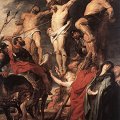 Among Rubens' major works from the second decade of the century are the religious paintings The Last Judgment (c. 1616; Alte Pinakothek, Munich) and Christ on the Cross (1620; Royal Museum of Fine Arts, Brussels) and the mythological paintings Battle of the Amazons (c. 1618; Alte Pinakothek) and Rape of the Daughters of Leucippus (c. 1617-18; Alte Pinakothek). His pictures of wild animals culminated in the Hippopotamus Hunt (c. 1615-16; Alte Pinakothek) and similar hunting scenes.
Among Rubens' major works from the second decade of the century are the religious paintings The Last Judgment (c. 1616; Alte Pinakothek, Munich) and Christ on the Cross (1620; Royal Museum of Fine Arts, Brussels) and the mythological paintings Battle of the Amazons (c. 1618; Alte Pinakothek) and Rape of the Daughters of Leucippus (c. 1617-18; Alte Pinakothek). His pictures of wild animals culminated in the Hippopotamus Hunt (c. 1615-16; Alte Pinakothek) and similar hunting scenes.
Diplomatic career
In the period between 1621 and 1630, Rubens was increasingly used as a diplomat by the Spanish Habsburg rulers. His contact with the leading political and intellectual figures of Europe, as well as his gracious manner, made him the ideal political agent. Furthermore, as a painter, he could often act as a covert diplomat or observer. His first important diplomatic functions were in connection with the attempt of Spain to renegotiate the Twelve Years' Truce (1609-21) between the Habsburg-controlled area of Flanders and the Dutch Republic to the north. Rubens became an adviser to Archduchess Isabella, the regent of Flanders and daughter of the Habsburg ruler of Spain, Philip II. On her behalf Rubens tried to intercede with the Dutch, but war soon broke out again in the Netherlands between the Protestant Dutch and the Catholic Flemish and continued for the rest of Rubens' life.
Early in 1622 Rubens was summoned to Paris by Marie de Medicis, the widow of Henry IV and mother of the reigning king of France, Louis XIII. This Florentine princess, whose wedding by proxy Rubens had attended in Florence in 1600, commissioned him to paint two series of paintings for two long galleries in her newly constructed Luxembourg Palace. One cycle of 21 pictures representing episodes from Marie's life now hangs in the Louvre Museum, while the other proposed series of pictures, dealing with the life of Henry IV, was never completed. After six weeks of discussion and arrangements, Rubens returned to Antwerp, where he worked for two years on this, his most artistically important secular commission. He returned to Paris in 1625 to install the Marie de Medicis pictures.
In 1628 Rubens traveled to Madrid, where he tried to lay the groundwork for peace negotiations between Spain and England. There he was made an envoy by King Philip IV and sent on a special peace mission to Charles I of England in 1629. It is to Rubens' personal diplomacy that the peace treaty of 1630 between England and Spain can largely be attributed. In reward for his services he was knighted and given an honorary degree by Cambridge University. Charles I also commissioned him to decorate the ceiling of the royal Banqueting House (1619-22) designed by the court architect Inigo Jones as a part of Whitehall Palace. Finished in 1634, the nine huge panels allegorize the reign of James I, the father of Charles I.
Late years in Flanders
On his return to Flanders in 1630, Rubens was rewarded by the archduchess with exemption from further diplomatic missions. The peace Rubens had worked for nearly 10 years to achieve, however, did not last, and for most of the next 20 years Europe continued to be embroiled in the Thirty Years' War.
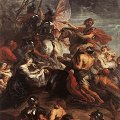 Having been a widower for four years, Rubens in 1630 married the 16-year-old Helena Fourment, whose charms recur frequently in such late figure paintings as The Garden of Love (1634; Prado Museum, Madrid), The Three Graces (c. 1638-40; Prado), and The Judgment of Paris (1638-39; Prado), as well as in Helena Fourment with Fur Cloak (c. 1638-40; Kunsthistoriches Museum, Vienna) and other portraits. Rubens bought the chateau of Elewijt in 1635, and in his last years he spent much time there depicting the rural life and scenery outside of Antwerp in such paintings as The Kermesse (c. 1636-38; Louvre Museum, Paris). His long-established interest in landscape painting reached its grandest and most emotionally romantic expression in such late works as Landscape with a Rainbow (c. 1634; The Hermitage, St. Petersburg) and Chateau de Steen (c. 1635-37; National Gallery, London). Rubens' major commission during these last years, however, was to provide for King Philip IV of Spain (the brother of the infante Ferdinand, who had succeeded Archduchess Isabella as regent of Flanders) models for about 120 scenes from the writings of the Roman poet Ovid and other classical authors to decorate the Torre de la Parada, the royal hunting lodge near Madrid. Rubens died at Antwerp in 1640 when gout, which had for months troubled his painting arm, reached his heart.
Having been a widower for four years, Rubens in 1630 married the 16-year-old Helena Fourment, whose charms recur frequently in such late figure paintings as The Garden of Love (1634; Prado Museum, Madrid), The Three Graces (c. 1638-40; Prado), and The Judgment of Paris (1638-39; Prado), as well as in Helena Fourment with Fur Cloak (c. 1638-40; Kunsthistoriches Museum, Vienna) and other portraits. Rubens bought the chateau of Elewijt in 1635, and in his last years he spent much time there depicting the rural life and scenery outside of Antwerp in such paintings as The Kermesse (c. 1636-38; Louvre Museum, Paris). His long-established interest in landscape painting reached its grandest and most emotionally romantic expression in such late works as Landscape with a Rainbow (c. 1634; The Hermitage, St. Petersburg) and Chateau de Steen (c. 1635-37; National Gallery, London). Rubens' major commission during these last years, however, was to provide for King Philip IV of Spain (the brother of the infante Ferdinand, who had succeeded Archduchess Isabella as regent of Flanders) models for about 120 scenes from the writings of the Roman poet Ovid and other classical authors to decorate the Torre de la Parada, the royal hunting lodge near Madrid. Rubens died at Antwerp in 1640 when gout, which had for months troubled his painting arm, reached his heart.
Achievement
Rubens was one of the most methodically assimilative and most prodigiously productive of Western artists. His abundant energy fired him to study and emulate the masters both of antiquity and of the 16th century in Rome, Venice, and Parma. His warmth of nature made him responsive to the artistic revolutions being worked by living artists, and robust powers of comprehension nourished his limitless resource in invention. He was able to infuse his own astounding vitality equally into religious and mythological paintings, portraits, and landscapes. He organized his complex compositions in vivid, dynamic designs in which limitations of form and contour are discounted in favour of a constant flow of movement. Rubens' voluptuous women may not be to the taste of modern viewers but are related to the full and opulent forms that were the ideal of womanhood during the Baroque period.
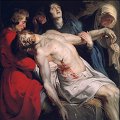 The larger the scale of the undertaking the more congenial it was to Rubens' spirit. The success of his public performance as master of the greatest studio organization in Europe since Raphael's in Rome has obscured for many the personal intensity of his vision as evinced in such works as his oil sketch for All Saints (Museum Boijmans Van Beuningen, Rotterdam) and in his deeply felt study for the head of St John in the Antwerp cathedral Descent from the Cross, as well as in portraits of his family and friends and in his treatment of the mood and grandeur of landscape. Rubens' most immediate influence was on Sir Anthony Van Dyck, Jacob Jordaens, and other painters in Flanders, but artists at almost every period have responded to the force of his genius. He is a central figure in the history of Western art.
The larger the scale of the undertaking the more congenial it was to Rubens' spirit. The success of his public performance as master of the greatest studio organization in Europe since Raphael's in Rome has obscured for many the personal intensity of his vision as evinced in such works as his oil sketch for All Saints (Museum Boijmans Van Beuningen, Rotterdam) and in his deeply felt study for the head of St John in the Antwerp cathedral Descent from the Cross, as well as in portraits of his family and friends and in his treatment of the mood and grandeur of landscape. Rubens' most immediate influence was on Sir Anthony Van Dyck, Jacob Jordaens, and other painters in Flanders, but artists at almost every period have responded to the force of his genius. He is a central figure in the history of Western art.
Rubens' own deepest love as a painter, consummated by his second visit to Spain, was for the poetry, the control of glowing colour, and the sheer mastery in handling of oil paint that distinguish the art of Titian. In these qualities Rubens himself became supreme, whether with the brilliant play of fine brushes over the white reflecting surface of a small panel, or with masterful gestures often more than six feet long, sweeping a richly loaded brush across a huge canvas. Rubens's influence in 17th-century Flanders was overwhelming, and it was spread elsewhere in Europe by his journeys abroad and by pictures exported from his workshop, and also through the numerous engravings he commissioned of his work. In later centuries, his influence has also been immense, perhaps most noticeably in France, where Watteau, Delacroix, and Renoir were among his greatest admirers. Because of the unrivalled variety of his work, artists as different in temperament as these three could respond to it with equal enthusiasm.
Peter Paul Rubens Art
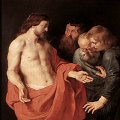
|
|
More
Articles
 Art Encyclopedia A world history of art in articles.
Art Encyclopedia A world history of art in articles.
Baroque
Peter Paul Rubens
Art and life. Biography.
Early mythological paintings.
Late mythological paintings.
Early religious paintings.
Late religious paintings.
Portraits.
Landscapes.
Art
 Art Wallpapers Art image collections for your desktop.
Art Wallpapers Art image collections for your desktop.
Caravaggio Art, $25
(100 pictures)
Rubens Art, $29
(200 pictures)
Rembrandt Art, $25
(160 pictures)

